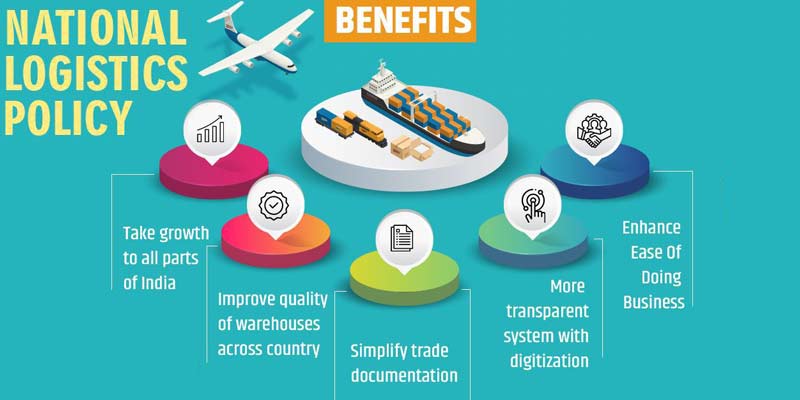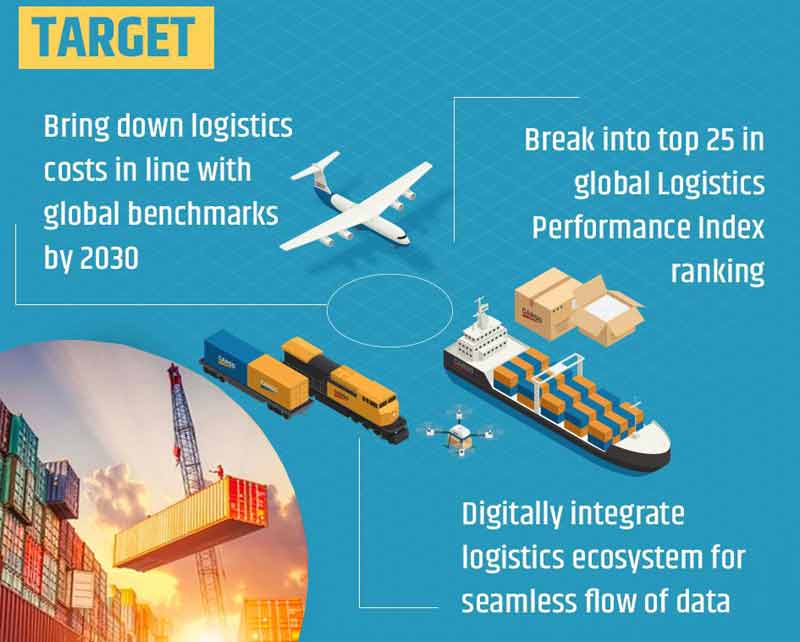- India
- Sep 19
Explainer / National Logistics Policy
Prime Minister Narendra Modi unveiled the National Logistics Policy that seeks to address challenges facing the transport sector and bring down the logistics cost of businesses from 14 per cent to a single digit. He said the policy aims to expedite the last-mile delivery, helping businesses save time and money.
India’s logistics sector
• The logistics sector is the backbone of economic growth in India and is one of the most important accelerators of trade.
• Logistics has been given special focus in the last few years, and many measures in terms of hard and soft infrastructure have been taken to improve the logistics scenario of India.
• According to the commerce ministry, while the Indian logistics sector has been growing at a compound annual growth rate (CAGR) of 10.5 per cent, reaching about $215 billion in value during 2020, there are systemic, interconnected problems that must be addressed to enhance its efficiency.
• Comprehensive logistics costs amount to almost 14 per cent of India’s gross domestic product, which is higher than other countries in the world.
Significance of National Logistics Policy
• National Logistics Policy has been developed after wide consultations with all central ministries on the supply and demand side and takes a comprehensive view of the sector defining specific action points with the key objective of matching and improving upon global standards in logistics efficiency and to integrate with global supply chains.
• Closing India’s competitiveness gap vis-à-vis the global average of 8 per cent, would make the Indian logistics sector advanced, organised and efficient, on par with global peers with the ambition of being amongst the top-25 countries in the global Logistics Performance Index (LPI).
• Reduced logistics cost improves efficiency cutting across various sectors of the economy, encouraging value addition and enterprise.
• The government has put significant emphasis on improving both Ease of Doing Business and Ease of Living. National Logistics Policy, a comprehensive effort to address issues of high cost and inefficiency by laying down an overarching interdisciplinary, cross-sectoral and multi-jurisdictional framework for the development of the entire logistics ecosystem, is yet another step in this direction.
• The policy is an endeavour to improve competitiveness of Indian goods, enhancing economic growth and increasing employment opportunities.
• Logistics efficiency is a function of infrastructure, services (digital systems/ processes/ regulatory framework) and human resource.
Highlights of the policy
• While development of integrated infrastructure and network planning is envisaged to be addressed through the PM Gati Shakti National Master Plan, for efficiency in services (processes, digital systems, regulatory framework) and human resource, the National Logistics Policy is the logical next step. This will provide a comprehensive agenda for development of the entire logistics ecosystem.
• The vision of the policy is to develop a technologically enabled, integrated, cost-efficient, resilient, sustainable and trusted logistics ecosystem in the country for accelerated and inclusive growth.
• Seeking to support faster growth after two pandemic-ridden years, the policy will streamline rules and address supply-side constraints as well as provide a roadmap to reduce fuel costs and lower logistics costs.
• The policy aspires to reduce cost of logistics in India to be comparable to global benchmarks by 2030 and create data driven decision support mechanism for an efficient logistics ecosystem.
• Elements of the policy like Unified Logistics Interface Platform (ULIP) and Ease of logistics Services (E-Logs) would help exporters and industry in enhancing logistic efficiency.
• The ULIP will bring all the digital services related to the transportation sector into a single portal, freeing the exporters from a host of very long and cumbersome processes.
• Similarly, E-Logs portal has also been started, through which industry can directly take up any such matters which are causing problems in their operations and performance with the government agencies.
• The policy will be implemented through a Comprehensive Logistics Action Plan (CLAP). The interventions proposed under the CLAP are divided into eight key action areas.
They are:
i) Integrated digital logistics systems
ii) Standardisation of physical assets and benchmarking service quality standards
iii) State engagement
iv) Human resource development and capacity building
v) Export-import logistics
vi) Sectoral plans for efficient logistics
vii) Service Improvement framework
viii) Facilitation of the development of logistics parks.
• Under human resource development, the focus would be given to mainstream logistics in higher education, and the development of online training programmes.
• Under export-import logistics, the focus would be on addressing infrastructure and procedural gaps, and developing institutional mechanisms for trade facilitation.
• Similarly, as part of service improvement framework, the policy would talk about improvement in regulatory interface to enable seamlessness between sectors.
• An empowered group of secretaries (EGoS), constituted under the PM Gati Shakti, would monitor and review the implementation of the policy.
Manorama Yearbook app is now available on Google Play Store and iOS App Store


